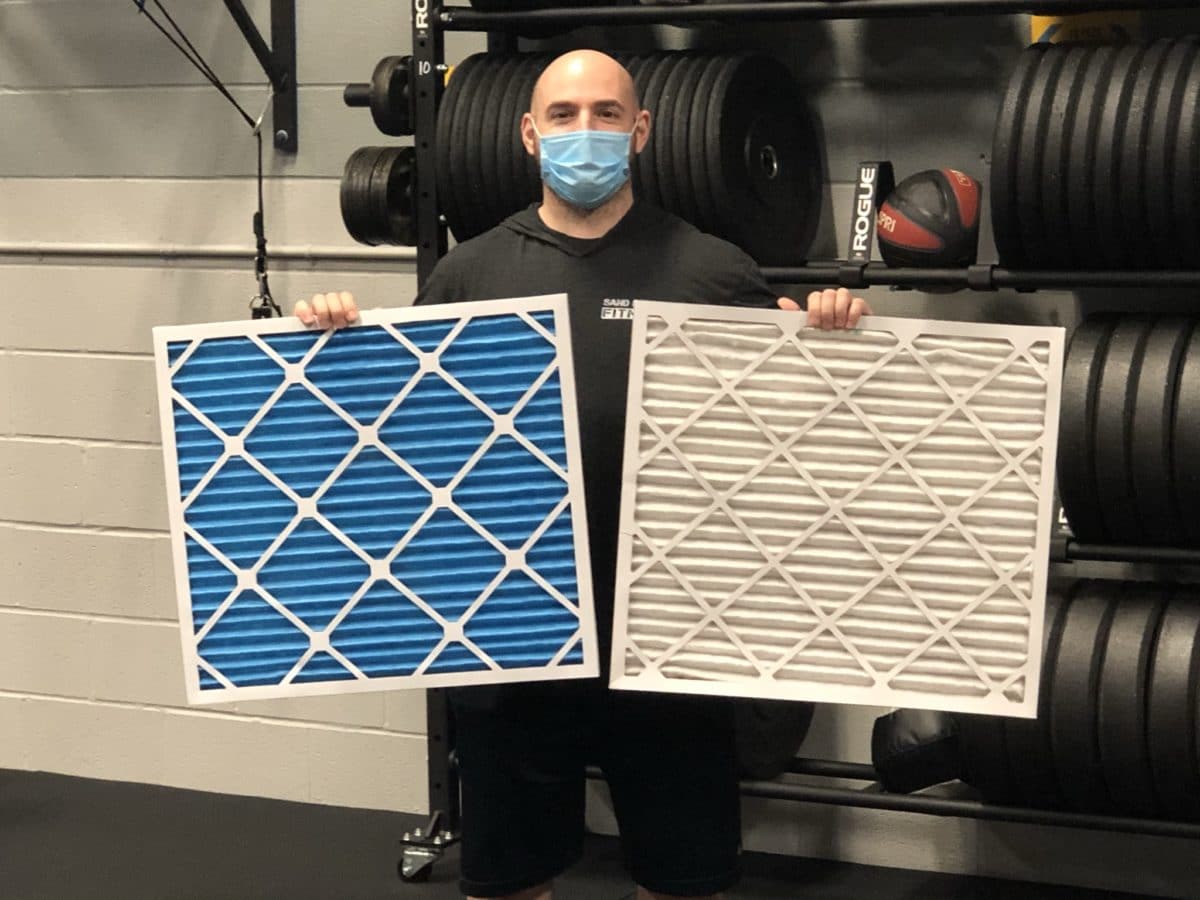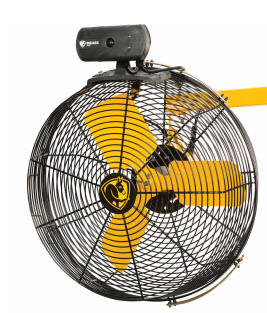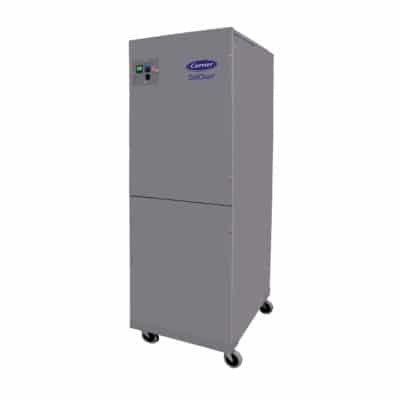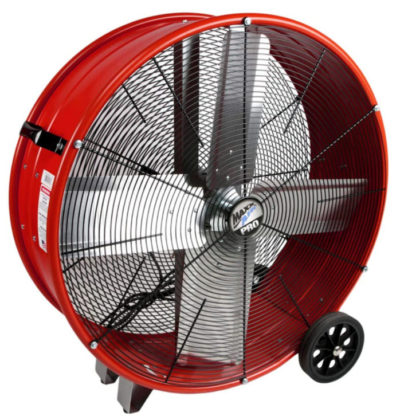MERV-13 Air Filters — What they Are, Whether They Are Safe to Install, and What Impact They’ll Have on Protecting your Gym Members from COVID-19.
Why You Should Read This Article on MERV-13 Filters for COVID-19 and Gyms
I know it’s long. 3400+ words… imagine how long it took me to write. Upgrading your filter is not as simple as you think it is. Protecting your members from COVID-19 is also not a matter of slipping in a new filter. I don’t sell air filters. I don’t sell HVAC systems. I have no financial bias to convince you to purchase a MERV-13 filter for your business other than I want the impact of COVID-13 in Virginia to be as small as possible. What I can tell you is that I am very thorough in my research. And I did this research to protect our employees, our members, our HVAC equipment, and my own health. And so here it is, everything I learned about HVAC filtration, and the impact a MERV-13 filter can have on air quality, COVID-19 Filtration, and the health of your members.
–Coach Paul. Biomedical Engineer, JHU
Our HVAC Came with a MERV-10 Filter… Should We Upgrade?
After all the research and analysis, talking with suppliers, and some HVAC installers, the threshold answer as to whether your should upgrade is…
Yes, upgrading your HVAC system to MERV-13 filter is an effective solution for reducing recirculation of SARS-CoV-2 virus in the air. However, just because you can slide in an M13 filter into your HVAC system, doesn’t mean you should.
A MERV-13 filter will substantially reduce the air flow into your HVAC compressor. This pressure drop can cause the coils to freeze, causing massive damage to your system. Certainly some HVAC systems can handle this pressure drop, but what about yours?
Just look it up in the documentation right? It’s not that simple … we spoke Carrier about this issue, and you actually need an HVAC technician come into your facility to measure the change in fan speed created by swapping the filters. There are formulas they use determine the output of the fan. A standard 6-ton system should have 400 cubic feet per minute and a minimum of 325 cubic feet. So you’ll actually need to hire someone to check to see if the new filters will create any problems in your system.
So, not only will upgrading to MERV-13 increase the wear on your HVAC system and increase your electricity costs … the MERV-13 filters also cost a lot more than standard MERV-10 filters — especially right now. But the real cost will be damaging your HVAC system, if your system can’t handle the reduction in air flow.
Understanding the M13 Pressure Drop Issue
The higher the efficiency filter, the greater the pressure drop will be. Also of importance is the thickness of the filter. Filters come in one inch, two inches, and four inches. Thicker filters have smaller pressure drops. So if you are thinking of going from an M8 to an M13 filter and you have a one inch filter, you really should have an HVAC Technician measure your blower fan speed after install to make sure your HVAC system can handle it.
What is a MERV 13 Filter?
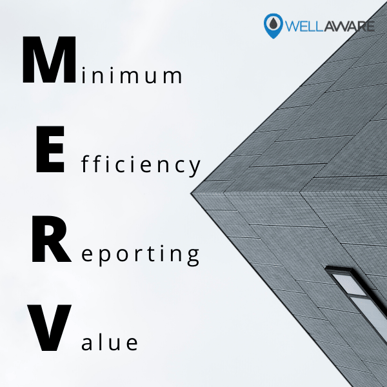 Before COVID-13, I had never heard of MERV-13. I hadn’t heard of it until Governor Cuomo in New York announced that he was requiring businesses in New York to have a MERV-13 filters. Dawn found the press release and asked me whether we had MERV-13 filters in our HVAC system. I didn’t have a clue. Our HVAC system is brand new, and I hadn’t even ordered replacement filters yet. So I consulted three online youtube videos on how to actually replace our air filters. Low and behold, we have MERV-10.
Before COVID-13, I had never heard of MERV-13. I hadn’t heard of it until Governor Cuomo in New York announced that he was requiring businesses in New York to have a MERV-13 filters. Dawn found the press release and asked me whether we had MERV-13 filters in our HVAC system. I didn’t have a clue. Our HVAC system is brand new, and I hadn’t even ordered replacement filters yet. So I consulted three online youtube videos on how to actually replace our air filters. Low and behold, we have MERV-10.
Filters for HVAC have three main specifications:
Size: generally inches 22 x 24 inches. Width: 1 inches – 4 inches. And MERV (Minimum Efficiency Reporting Value). When you’re shopping for HVAC filters, you’ll learn there is a Nominal Size and an actual size. The standard difference between the nominal size and actual size is 1/2 inch. But often manufacturer’s make filters in 1/4 and 1/8 inch variations. People sell these variations on the internet at various filter distribution websites. So be sure that you compare your actual filter size with the actual filter size of the replacement. Otherwise, your filter might not fit.
MERV: most new HVAC systems accept filters from MERV-6 to MERV-13. Filters in HVAC systems are generally designed to protect the HVAC system itself, because small particles can damage internal components. However, air filters can also remove small particles from the air.
Is M13 Healthier for Your Members?
Yes it is – most of the time. So certified M13 filters are tested to remove at least 50% of particle sized .3 microns or larger.
Coronavirus and other virus particles are .12 microns, about 3 times smaller than the minimum size an M13 filter can remove. In the case of COVID-19, we are most concerned with SARS-CoV-2 being attached to water droplets that are exhaled through coughing, breathing, and sneezing. The Lancet studied the sizes of numerous infectious agents and their particle size. They found
Studies of cough aerosols and of exhaled breath from patients with various respiratory infections have shown striking similarities in aerosol size distributions, with a predominance of pathogens in small particles (<5 μm). These are immediately respirable, suggesting the need for personal respiratory protection (respirators) for individuals in close proximity to patients with potentially virulent pathogens. There is no evidence that some pathogens are carried only in large droplets. Surgical masks might offer some respiratory protection from inhalation of infectious aerosols, but not as much as respirators. However, surgical masks worn by patients reduce exposures to infectious aerosols to health-care workers and other individuals.
Infection control guidelines have stated that most respiratory infections are transmitted by respiratory droplets—ie, particles larger than 5–10 μm in size. Airborne transmission has been attributed to only a few pathogens, notably Mycobacterium tuberculosis, via infectious droplet nuclei that are particles sized 5 μm or smaller. The use of airborne infection isolation rooms and respirator masks has been recommended only to protect against airborne transmission.
A re-analysis of the size of particles emitted by an average person that would fall to the ground within 2 m is 60–100 μm, and these can be carried more than 6 m away by sneezing.Lancet
Similar to what the Mayo clinic found, COVID-19 is transmitted on very small particles. The threshold question becomes… is a M13 filter fine enough to filter out SARS-CoV-2?
So Respiratory Research tells us that humans can exhale particles as small as .01 microns. SARS-CoV-2 is .13 microns. So it’s possible that a person with SARS-CoV-2 can exhale infectious aerosols smaller than the minimum size a M13 filter can remove. So while an N95 will protect you, an M13 filter might not. I say might, because most exhaled particles are .7 microns or larger. And filtration of particles in the .7-1.0 μm size is size that the M13 filter can remove — 50% of the time.
So, yes, Governor Cuomo is right — you should upgrade your HVAC system to M13, but you need to hire an HVAC technician to make the pressure drop doesn’t drop your air flow speed below the minimum requirements. If it does, you need to consider an alternative solution.
What is a MERV rating?
|
MERV Rating |
Average Particle Size Efficiency in Microns |
|---|---|
|
1-4 |
3.0 – 10.0 less than 20% |
|
6 |
3.0 – 10.0 49.9% |
|
8 |
3.0 – 10.0 84.9% |
|
10 |
1.0 – 3.0 50% – 64.9%, 3.0 – 10.0 85% or greater |
|
12 |
1.0 – 3.0 80% – 89.9%, 3.0 – 10.0 90% or greater |
|
14 |
0.3 – 1.0 75% – 84%, 1.0 – 3.0 90% or greater |
|
16 |
0.3 – 1.0 75% or greater |
Filtration Speed
The blower in your HVAC system will pull a certain amount of air through the filter. We have two blowers each pulling 400 cubic feet per minute. Our gym has roughly 80,000 cubic feet of air space. So to clean all the air in the gym, it will take 100 minutes. But doesn’t mean 100% of the .3 micron sized particles are removed. Only 50% are removed… And if you know anything about probability analysis … you’ll know that it won’t take 200 minutes either. After 2 cycles, 200 minutes only 75% of the particles are removed. It will take on average 5 cycles (500 minutes, 8 hours) to remove 97% of the .3-1 micron particles. But that analysis assumes you aren’t adding more. But if you own a gym with live clients breathing all the time, you certainly are adding more particles all day long. So even with a dual MERV-13 system, you are maybe removing 50% of the .3 micron particles… and very little particles that are smaller.
Therefore, a Merv-13 Equipped System is not Enough to Protect your Members
If you get a member not wearing a mask that is COVID-19 positive, there is a large risk he or she can spread it to other members. With COVID-19 infection rates on the rise, the chances of this happening in your gym will be going up. Right now, the infection rate in Virginia is 2%.
HEPA vs Merv 13
So we know that MERV-13 is a step in the right direction. What about HEPA filters? While HEPA filters have been around for 60+ years, they are undisputed champion at removing small particles from the air. A HEPA Filter (High Efficiency Particulate Air) can remove at least 99.97% of dust, pollen, mold, bacteria, and any airborne particles with a size of 0.3 microns (µm). The diameter specification of 0.3 microns responds to the worst case; the most penetrating particle size (MPPS). Particles that are larger or smaller are trapped with even higher efficiency. Using the worst case particle size results in the worst case efficiency rating (i.e. 99.97% or better for all particle sizes). They are so powerful, we equipped our Rigid Shop Vac with a HEPA filter, so we don’t aerosolize viruses back into the air when we vacuum.
How HEPA Filtration Works
The largest of the particulates, about 0.5 micron and above, are captured via impaction: Unable to change their course due to momentum, they simply slam into the fibers and stick to them.
Particles less than 0.5 micron, but not too much less, are captured by interception: Their lower momentum allows them to flow around some fibers, but eventually they come close enough to touch one fiber on the way by, and again they stick.
Finally, very fine particles, namely those below 0.1 micron, or at most one-fifth of the diameter of the fibers, get bounced around randomly and slowed by their interactions with atmospheric atoms and molecules, and eventually drift or get bounced into a filter fiber, whereupon (yet again) they stick; this process is called diffusion. The net result is that virtually all particles get captured quickly, while airflow is only slightly impeded.
Crucially, the hardest particles to capture are what you might call the Baby Bears: At 0.3 micron, they’re at the low limit of interception momentum and above the limit of diffusion—in other words, they’re “just right” to get through a HEPA filter. The solution is to make the filter dense enough that it has a sufficient amount of fibers to capture most of the 0.3-micron particles. And again, according to the US HEPA standard, “most of them” means 99.97% of them in a single pass.New York Times
So HEPA filters are the gold standard. But how can you clean your whole gym with a HEPA filter? Fact is, most HVAC systems support MERV-13 at best?
Bringing HEPA Power Into Your Gym
Carrier and other HVAC companies make dedicated HEPA filtration air handlers that have one purpose … to the clean the air. HEPA filters are very efficient at removing extremely small particle sizes like viruses. Plus since it’s a standalone unit designed to handle a HEPA filter, you don’t have to worry about breaking your HVAC system. These systems are very expensive, several thousand dollars. But we think the health of our employees and members is worth the investment. So yes, getting a MERV-13 filter in your HVAC system is a positive step in the right direction, but a dedicated air filtration unit is a better method. It’s worth noting that if you added a HEPA filter to your HVAC system, you should call an HVAC technician right away.
Air Cycle Time
Even if you get a high efficiency filter like a HEPA filter or MERV 16 filter — the air in the room has to pass through the system for the air handling system to clean the air. Our HVAC system moves 400 Cubic Feet of air per minute. In our 4000 square foot gym, we have 80,000 cubic feet of air. So it would take our HVAC system 200 minutes (or 3.33 hours) to cycle through all the air in our gym. But since we actually have a dual HVAC system, it’s actually 100 Minutes or an hour and half. That’s pretty good, but we want to do better, because 1.5 hours of potential exposure is still too much.
Big Ass Fans Clean Air System & Carrier Opticlean
We purchased the Big Ass Fan Clean Air Bi-polar Ionization System which blows bi-polar ionized air through the gym, effectively killing the SARS-CoV-2 virus in 10-30 minutes. Our Air Eye Big Ass Fan moves 3600 Cubic Feet of air westward and our Max Air Drum Fan moves 5500 Cubic Feet of Air eastward. Our Carrier Opticlean System sits in the middle, sucking in all the air and cleaning it. The Opticlean system can process 1500 cubic feet of air per minute. Meaning it clean the whole gym in less than an hour.
All the Air, ionized, filtered, and disinfected in less than an hour. There is no place for COVID-19 to Hide at Sand & Steel
Air Quality Sensors
But we take it a step further… we actually measure and display the Air Quality Index, PM2.5, and TVOCs in real time at Sand and Steel Fitness. This way you know the air is clean.
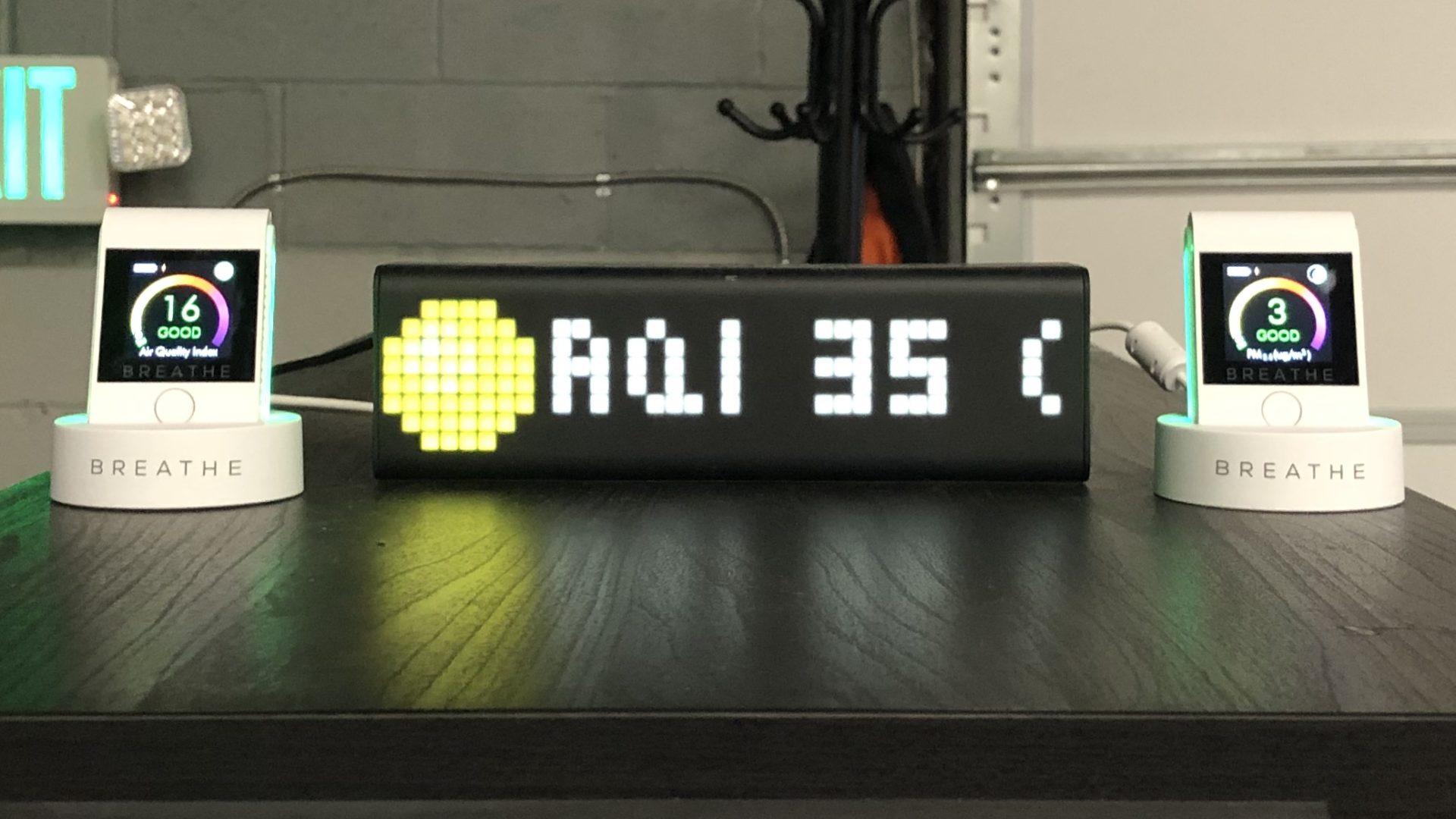
Choosing a Filter for Your Gym
When you buy a filter, make sure it is independently tested by NAFA. A MERV 13 rating means nothing, if NAFA hasn’t certified it. HVAC filters are relatively cheap, but putting the wrong one in your HVAC system can cost you tens of thousands of dollars. Buying an off-brand, uncertified HVAC filter is not a good idea.
For the purpose of this article, we actually bought some cheap filters from a Google Store company, FilterBuy. They have a 4.7/5 rating with thousands of good reviews. We ordered some of their Merv-13 filters. Complete trash. Literally, the filter was separating from the mesh when I took it out. The filter itself was coming apart. The density of the filter material was uneven. You get what you pay for. I can’t imagine how poorly this filter would perform under NAFA testing.
MERV Filter FAQ
What’s in Your HVAC System?
Most HVAC installers will select a MERV 6 to MERV 8 filter. Those filters are sufficient to protect the HVAC system. So unless you changed it, chances are that is what’s in your air return.
How Much is a MERV-13 Filter?
They generally cost about 2.5-4 times the price of a MERV-8 filter. Apparently the equipment to make MERV-13 filters is more expensive to buy and maintain. Air filters need to be replaced every 3 months or so.
How Much is a MERV-8 Filter?
It varies depending on the manufacturer, size, and width. Ballpark is $10-$25 for one MERV-8 Filter.
Why Should You Get a MERV-13 Filter in Your Gym or Business?
Simple answer — a higher MERV rating means the filter will remove smaller particles from the air. A recent benchmark test from texairfilters2 showed the effectiveness of a MERV 13 filter connected to a box fan.
| Breakroom | After Fan and Filter | Removed by Filter | % Removed | |
| 0.3 um | 2,514,400 | 1,415,000 | 1,099,400 | 43.7% |
| 0.5 um | 106,500 | 51,100 | 55,400 | 52.0% |
| 1 um | 13,400 | 3,400 | 10,000 | 74.6% |
| 2.5 um | 2,900 | 400 | 2,500 | 86.2% |
| 5 um | 500 | 100 | 400 | 80.0% |
| 10 um | 100 | 100 | 0 | No change |
Analyzing the effectiveness a box fan + Merv-13 filter setup. One issue with the test though is that the particle count was measured right next to the fan. Rather doing an ambient test at different locations in the gym. Still, this test shows that Merv-13 filters can remove a good amount of particles form the air.
As I explained previously, the HVAC system isn’t really an air filtration system. If you want to filter your air for really small particles, you are better off with a HEPA filter. HEPA filters require very tight fittings to work, place severe load on the fan, and restrict the air flow significantly. So a dedicated system is best.
What About a MERV 12 or MERV 14 Filter?
The ability of filters to remove particles is well-documented. This chart from ASHRAE3, shows the minimum efficiency value for each MERV number. So if you want to best protect your clients and your employees, simple choose the highest MERV rating filter that your HVAC system supports.
ASHRAE Standard 52.2-2017 — Minimum Efficiency Reporting Value (MERV)
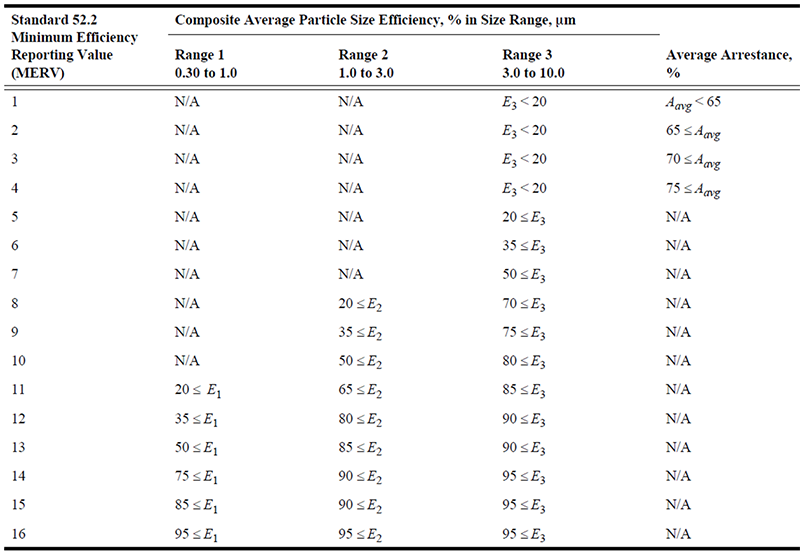
Filters are porous structures of fibers that remove particles from airstreams. The fraction of particles removed from air passing through a filter is termed “filter efficiency” and is provided by the Minimum Efficiency Reporting Value (MERV) under standard conditions. So MERV is a direct measure of filter efficiency. MERV ranges from 1 to 16; higher MERV = higher efficiency at removing particle. MERV ≥13 (or ISO equivalent) are efficient at capturing airborne viruses. High efficiency particulate air (HEPA) filters are more efficient than MERV 16 filters. However, increased filter efficiency generally results in increased pressure drop through the filter. Many HVAC can only handle a pressure drop of certain amount, so you’ll need to ensure your HVAC systems can handle filter upgrades without negative impact.
Efficiency Comes at Price
First, higher rated MERV filters are more expensive. Since a higher efficiency filter decreases the flow volume of air being pulled into your HVAC system, there is less hot air or cold air being dispersed by your HVAC system. This has the effect of increasing the amount of time your air conditioner and/or heater has to run. This raises your electric costs!!!!
How Much More Does it Cost to Run a MERV 13 Filter?
There are so many variables to that equation, it’s very hard to estimate. Factors include the efficiency of your HVAC system. Plus you have to take into account, ambient temperatures, thermal capacity, and insulation of your building. Plus variables like, the number of clients that enter and exit, heat from their bodies, etc., etc. The only way you’ll know for your building is compare electric costs once you have install your higher efficiency filters.
Ballpark Costs?
My research into the question came up with an estimate of about an 18% Increase in Energy Costs vs. Merv-8. This would be for an office. A CrossFit gym with concrete walls would be higher. MERV-13 and MERV-14 filters cause relatively high pressure drops compared to MERV-6 filters. So your HVAC system will need to run for a longer period of time, because there is less air blowing through it. This can result in thousands of dollars per year in increased energy costs. Wellaware.us
Gridium estimates that it will cost 1-2 cents per square foot in terms of energy costs to switch from M8 to M13. For a medium-sized space like ours, that’s around $100 a year.

Concluding Thoughts on MERV-13 HVAC Filters
I read about 100 different articles and published papers on COVID-19 transmission and HVAC filters. I consulted virologists and several HVAC companies and technicians. The single most complete article I found is this one by ASHRAE on Cleaning Air with filters. A dense article, but it’ll cover almost every air filtering option available. 4
So should you upgrade your system to an M13? If you know that it won’t damage your HVAC system, sure. But it’s only one arrow in quiver of anti-COVID-19 measures.
